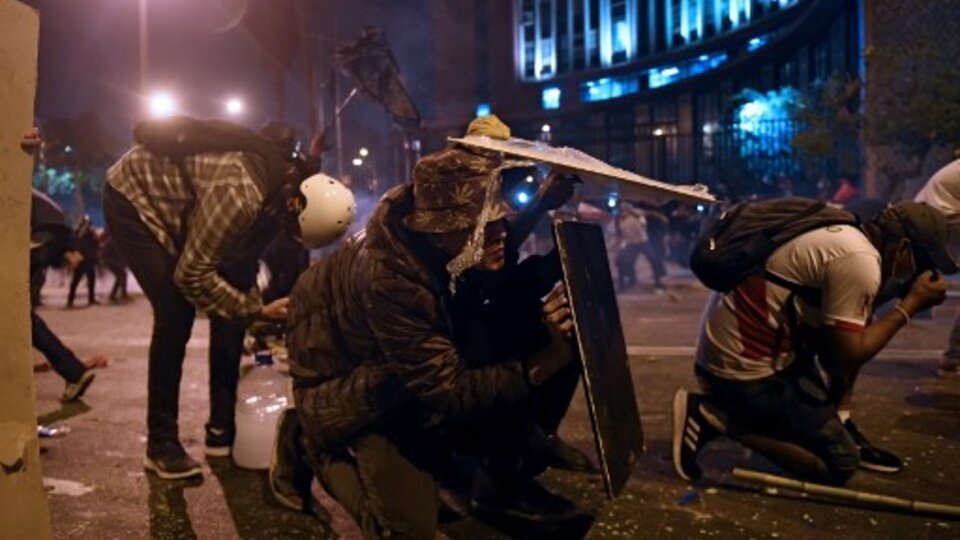
[ad_1]
From Lima
Congress put him in power, in a decision qualified by various sectors as a parliamentary coup, and six days later the street removed him from the presidency. The death on Saturday evening of two young people during anti-government protests sparked the last hours of Manuel Merino’s government, massively denounced as a “usurper”. This Sunday, Merino, whose situation was untenable, resigned from the presidency in a short televised message of just over five minutes. His resignation turned protests into celebrations. Thousands of citizens who were on the streets to demand his resignation began to celebrate. The cries of “Merino does not represent me”, “Out with the corrupt”, changed the “Yes, he could”. As soon as Merino finished speaking, cacerolazos were heard in all the towns, in all the districts of Lima. Cacerolazos that the last few days had been a demonstration, this Sunday was a celebration. At the time of this dispatch, the name of his successor was not known. This Sunday, the contested Congress will designate him.
Merino assumed the presidency last Tuesday, after 105 of 130 lawmakers the day before approved the impeachment of President Martín Vizcarra for “permanent moral incapacity”, a decision whose legality has been widely questioned and which has sparked outrage. public and massive protests, which They began Monday evening, as soon as the dismissal of Vizcarra and the appointment of Merino to the presidency were known, and they were repeated every day, until the fall of Merino.
In your short resignation message, Merino defended his brief and convulsed government, and saved the announcement of his resignation to last. He justified the decision of his parliamentary allies to impeach Vizcarra, a decision which sparked public outrage which took to the streets. He said he regretted the dead and that “all of Peru is in mourning,” but tried to discredit the massive protests against them by insisting that behind them were “groups interested in producing chaos and violence”. He came to government with votes from members of Congress who have multiple corruption complaints, but said he believed in “fighting corruption head-on.” It was an unfortunate message that ended a very brief and regrettable government.
The situation for the Merino government has become untenable after massive protests on Saturday night left two dead and more than a hundred injured. Authorities have denied information about the number of detainees. Forty demonstrators were missing. The deceased are two university students, Jack Pintado, 22, and Inti Sotelo, 24. Pintado died from multiple pellet hits to the face, neck and chest, Sotelo from a bullet in the chest. The mobilizations took place en masse across the country. Their deaths and injuries are a dramatic testimony to the Merino government’s brutal crackdown on citizen protests. Regarding this repression, Merino did not assume any responsibility in his resignation message. In Lima, the epicenter of the protests was in the center of the capital, but they repeated themselves simultaneously in various neighborhoods, from working-class neighborhoods to exclusive residential areas. The mobilizations took place across the country. These are the biggest protests that the country has long remembered.
Local human rights organizations, Inter-American Commission on Human Rights, Amnesty International, condemns crackdown on protests and they denounced that, in its agony, the Merino regime had put obstacles in the way of information about those detained during the protests.
Since Saturday evening, when the two deaths in the demonstrations became known, various political, social, academic, labor, commercial sectors, including the Church, demanded that Merino leave office. Even his allies in Congress, including Fujimorism and other right-wing groups, which put him in power less than a week ago, have taken away his support. His ministers, appointed Thursday in a far-right cabinet, began to resign one by one from midnight on Saturday. The collapsing government. Internationally, the Merino government had not been recognized by other countries.
Minutes before Merino, who went missing during the critical hours between Saturday and Sunday when everyone demanded his resignation, appeared on television giving the message in which he announced his resignation, the Congress which had brought him to power had already announced that if not resigned, they would resign him from his post.
The way Congress was to do this was to censor the board chaired by Merino, who, after Vizcarra’s impeachment by parliament, had assumed the country’s presidency in his capacity as president of Congress. If the legislature censures the board of the parliament headed by Merino, he would have to step down as President of the Republic because he was no longer head of Congress. With this decision by Parliament, Merino’s fate was defined. With no way out, he had no choice but to resign.
The presidency of the country would be assumed by the new president of the Congress. This election would take place in the next few hours. The popular demand is that this position be taken by one of the nineteen lawmakers who did not support Vizcarra’s impeachment. This opens the doors to one of the nine legislators of the centrist Purple Party, the only one of the nine seats to have voted en bloc against the departure of Vizcarra and the arrival of Merino at the Government Palace. The citizens were still in the streets awaiting the decision of Congress. If Parliament appointed a member of Congress who was part of the coalition that brought Merino to power, it would revive the protests.
.
[ad_2]
Source link
 Naaju Breaking News, Live Updates, Latest Headlines, Viral News, Top Stories, Trending Topics, Videos
Naaju Breaking News, Live Updates, Latest Headlines, Viral News, Top Stories, Trending Topics, Videos